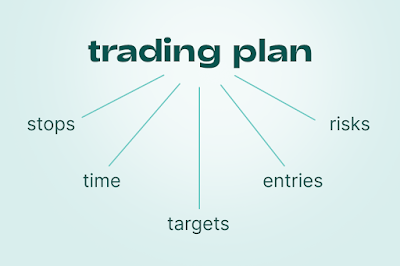Developing a trading plan is essential for building a successful trading strategy and managing your investments effectively. A well-thought-out trading plan helps you stay disciplined, minimize emotional decisions, and increase your chances of achieving your financial goals. Here are the steps to develop a trading plan:
Set Clear Goals:
Define your financial goals, both short-term and long-term. Determine what you aim to achieve with your trading activities, such as capital growth, income generation, or risk management.
Choose Your Trading Style:
Decide on your trading style based on your personality, time commitment, and risk tolerance. Common trading styles include day trading, swing trading, position trading, and long-term investing.
Select Markets and Instruments:
Determine the financial markets you want to trade (e.g., stocks, forex, commodities) and the specific instruments (e.g., individual stocks, currency pairs, commodities) you will focus on.
Develop Entry and Exit Criteria:
Create specific criteria for entering and exiting trades. Define technical and fundamental indicators you will use to identify potential trade setups, as well as rules for determining when to take profits or cut losses.
Risk Management:
Establish risk management rules to protect your capital. Determine the maximum percentage of your trading capital you are willing to risk per trade, and set stop-loss levels to limit potential losses.
Position Sizing:
Determine how much capital you will allocate to each trade based on your risk tolerance and trading strategy. Position sizing helps ensure that no single trade can significantly impact your overall portfolio.
Trading Psychology:
Address the psychological aspects of trading. Develop strategies to manage emotions, avoid impulsive decisions, and maintain discipline during periods of market volatility.
Backtesting:
Test your trading strategy using historical data to evaluate its performance over different market conditions. This helps you identify potential strengths and weaknesses in your approach.
Paper Trading:
Practice your trading strategy in a simulated or paper trading environment before committing real capital. This allows you to fine-tune your strategy and gain confidence without risking actual funds.
Monitor and Evaluate:
Continuously monitor your trades and evaluate your trading plan's performance. Keep track of your successes and failures, and be willing to adapt and make adjustments based on your findings.
Record Keeping:
Maintain a detailed trading journal to record your trades, including entry and exit points, reasons for the trade, outcomes, and any lessons learned. This helps you analyze your performance and make informed decisions.
Stay Informed:
Stay updated on market news, economic events, and relevant developments that could impact your trading positions.
Review and Adjust:
Regularly review your trading plan to ensure it remains aligned with your goals and objectives. Make adjustments based on changing market conditions, personal circumstances, or lessons learned from your trading experience.
Continuous Learning:
Commit to ongoing education and self-improvement. Stay informed about new trading strategies, techniques, and market trends to refine your skills over time.
Remember that developing a successful trading plan takes time, effort, and a willingness to learn from both successes and failures. It's also advisable to seek guidance from experienced traders or financial professionals and to consider your personal financial situation and risk tolerance before implementing any trading strategy.

Comments
Post a Comment